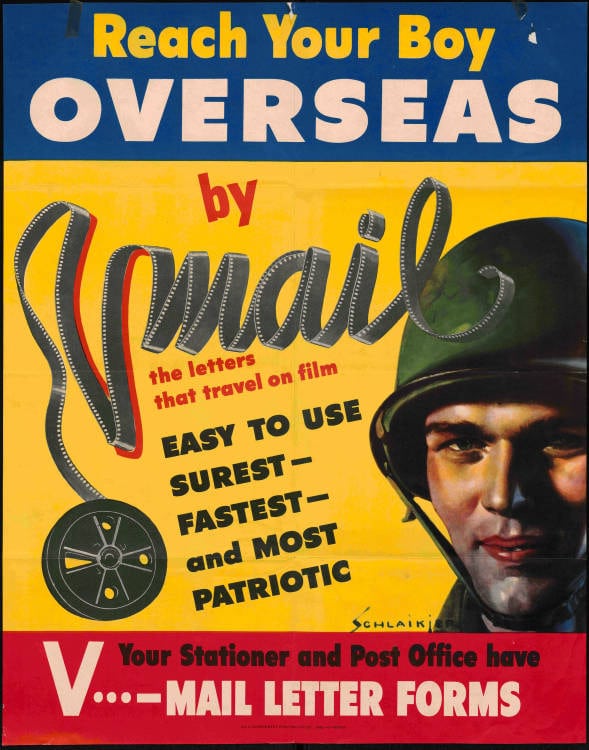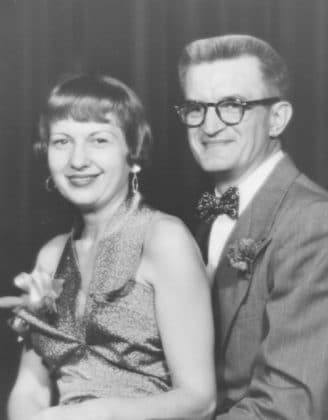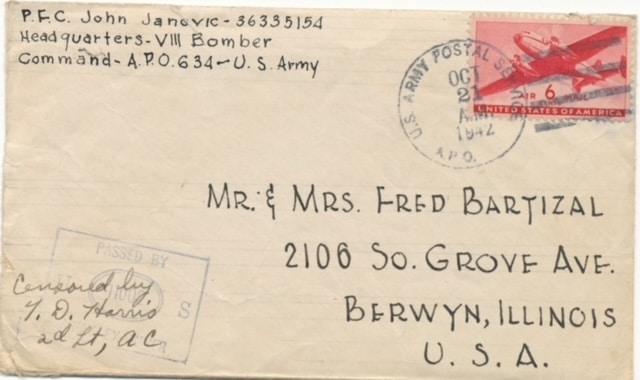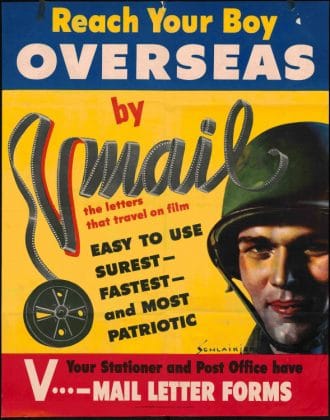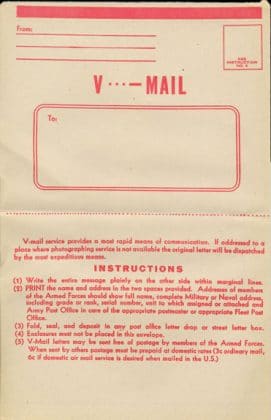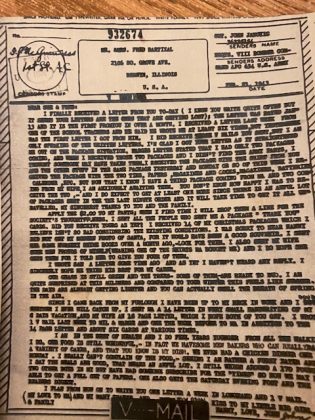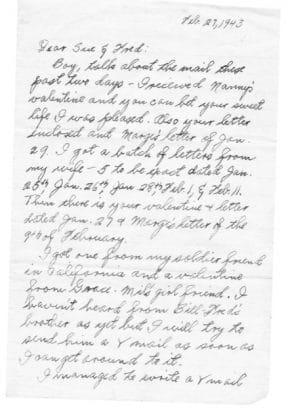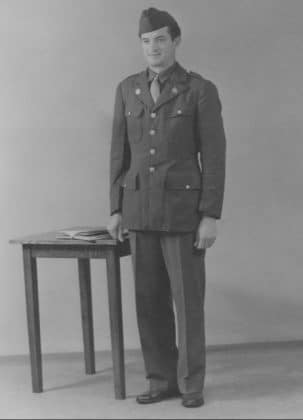Thousands of letters went back and forth during WWII. It was the main form of communication between servicemen and their loved ones. Each year that the war continued the volume of mail increased. It was a unique challenge.
The sheer volume of mail in WWII created the need for a better method of processing and delivery. Victory Mail or V-Mail was started in June of 1942 and continued until November 1945. It was a postal system developed to reduce the space needed to transport the mail. It was patterned after the British Airgraph of the 1930’s. Letters would be photographed and then reduced to thumb-nail sized images of microfilm.
My Uncle John referred to it in his war letters:
October 18, 1942….”My wife—I wrote to three times this week–including one V-mail as an experiment –and again today I will write another.”
November 19, 1942…”Mail is still moving like a lame duck in a pond. With your two V-mails of Sept 28 and Oct 1 and air mail from Marge of Oct 11 and one from my wife of Oct 12, none other has reached my hands for over five weeks.”
The machine used to make V-mail happen was a Recordak by Kodak and Company. 40 letters could be processed to film in a minute! 1600 letters could fit on a single reel of microfilm. Space for a reel took just 1 mail bag versus 37 mail bags! V-mail reduced both weight and bulk. It could free up cargo space on ships and planes. It could lighten the load. That meant more room for valuable war supplies!
How did someone write a V-mail? A special form was available. The page (just less than 8 x 10 inches) had space on it for the sender and recipient’s name plus room for the message. Instructions on how to fill it out were on the flip side. Then the whole page folded up. No need for stamps or envelopes! The sender could type up to 700 words on it. Or they could handwrite a message using a dark pen or pencil. (no light ink please!) Once submitted each V-mail was assigned a number and sent to the censors before being photographed.
At one time there were 10,000 censors employed between the United States and United Kingdom just to review WWII mail. They would block out any sensitive material. Their job was to prevent such information from being relayed to the enemy. It was forbidden to mention troop movements, size, strength, or location. In addition the censors had a responsibility to shield the families back home from anything bad. They would remove any words that might hurt civilian morale or put the war in a bad light. There were also special places to send your camera film for processing so that it could pass censorship.
More excerpts from my Uncle John’s war letters read:
October 5, 1942…” I also found some information as to why our mail is late. You know it has to first get censored by our officers-and they have a number of jobs to perform let alone the censor’s job–so you see sometimes the mail is held up here for two or three days. Then it goes to the British censor–maybe for four or five days and then across–most likely by boat. As more soldiers come, the job of getting mail sent will be slower–since there will be more mail to take care of.”
March 14, 1943 (He is writing by V-mail)…”The mailman was stingy to me, I received 2 letters and a V-mail, one from Marge (My notes: That is my Mom!) and one from my wife, both dated Feb 5 although one had an airmail stamp and one didn’t……How about my V-mail, have you been receiving them weekly? ”
June 11, 1943…”I used up two rolls of film my wife sent me on my trip, but we have to send our pictures to a certain censor base to have developed which sometimes takes as long as 6 weeks. I hope they come out although it was quite dark and cloudy most of the trip.”
V-mail took one to four weeks to arrive home. Mail was processed through one of three main hubs in San Francisco, Chicago, or New York City. Upon arrival the microfilm was restored to letter form. Lines of print returned—however they were somewhat smaller. Some stores even sold special V-mail magnifying glasses to read it! The numbering system allowed the sender to track V-mail from start to finish. Mail could be retrieved, and if needed, re-scanned. During WWII it was reported that no V-mail was ever lost!
A billion V-mails were sent during WWII. They were not as personal as old fashioned letters but servicemen used them because they were free and convenient. What would they write? My Uncle John wrote his day by day account much like a diary. He seemed to know what he could mention and what he had to leave out. His letters and V-mails showed no signs of the dreaded blacked-out areas of censorship.
Mail was important. Having six letters waiting on your bunk bed was like hitting the lottery! Uncle John wrote paragraphs on the status of mail—what had arrived—what was pending—what was out there somewhere, but not yet in his hands. He made requests for simple pleasures like candy or magazines. His family sent necessities like clothing and shoes. Uncle John never missed an opportunity to thank them and let them know how much he appreciated their thoughtfulness. He let them know he was doing well and that they shouldn’t worry.
Excerpts from my Uncle John’s war letters read:
November 28, 1942…”Got another batch of mail since I wrote you last Sunday or Monday. As I told you before –last Friday I received eight letters and five packages. Of the eight, five were from my wife. Monday I received ten more and thru the week about 8 more. …I finally found out who sent me those shirts. Tell Ma they were wonderful–fit swell, too.”
January 22, 1943…”Mil and Marge I received your lengthy letters–you gals are certainly becoming long letter writers. Looks like both of you may even be married before I come back. What surprises are in store for me!” (My notes: Marge was my mother. Mil was her younger sister. My Mom would marry on July 8, 1944.)
February 21, 1943…” I received the package with the shirt from you……and Monday or so of this week I received the package with the two tins, papers, magazines, socks, batteries, calendar, etc. but now I know I have a third package coming from Ma and two coming from my wife. I am anxiously awaiting them….My sincerest thanks to you and the family.”
Uncle John’s family wrote faithfully even when weeks went by without a reply. His sisters sent out letters every five days. His wife wrote three to four times per week. He heard from cousins, neighbors, and friends. Their devotion reminded him why he was there protecting and fighting. He knew that when this war was over he would join them again. Their letters, packages, cards, and V-mails reminded him that he was remembered. They assured him that he was missed and loved.

